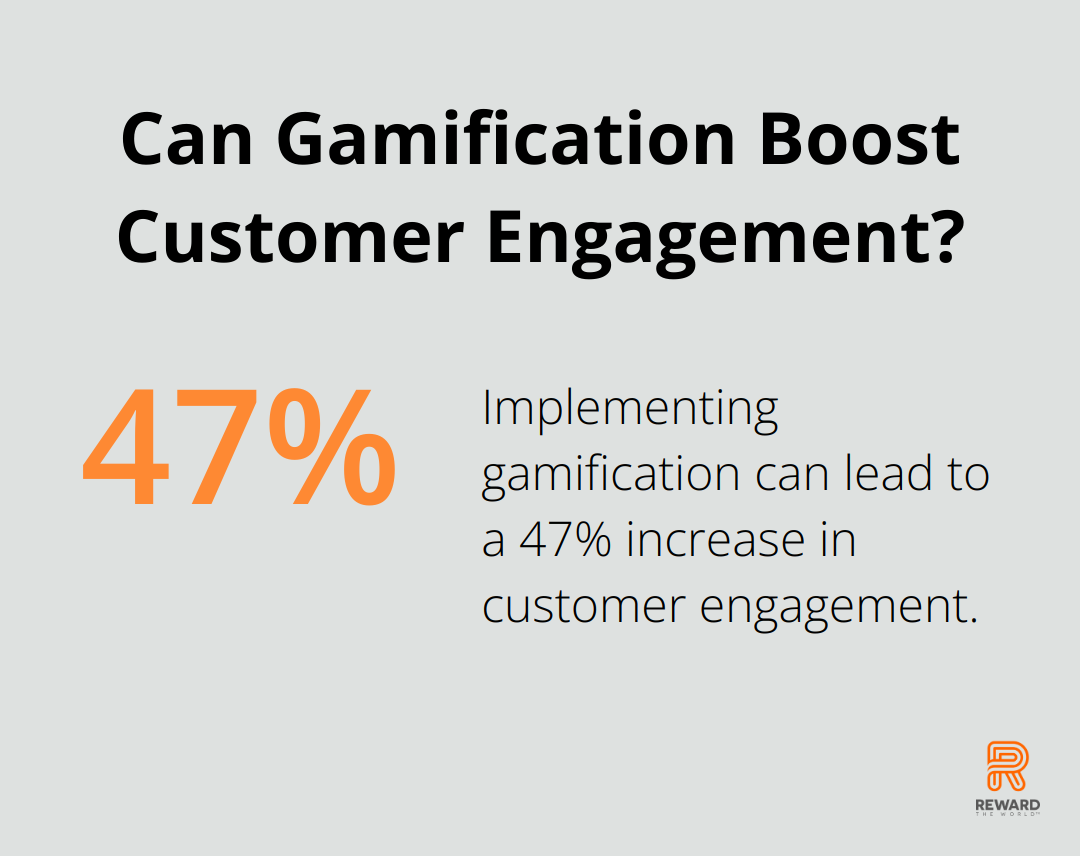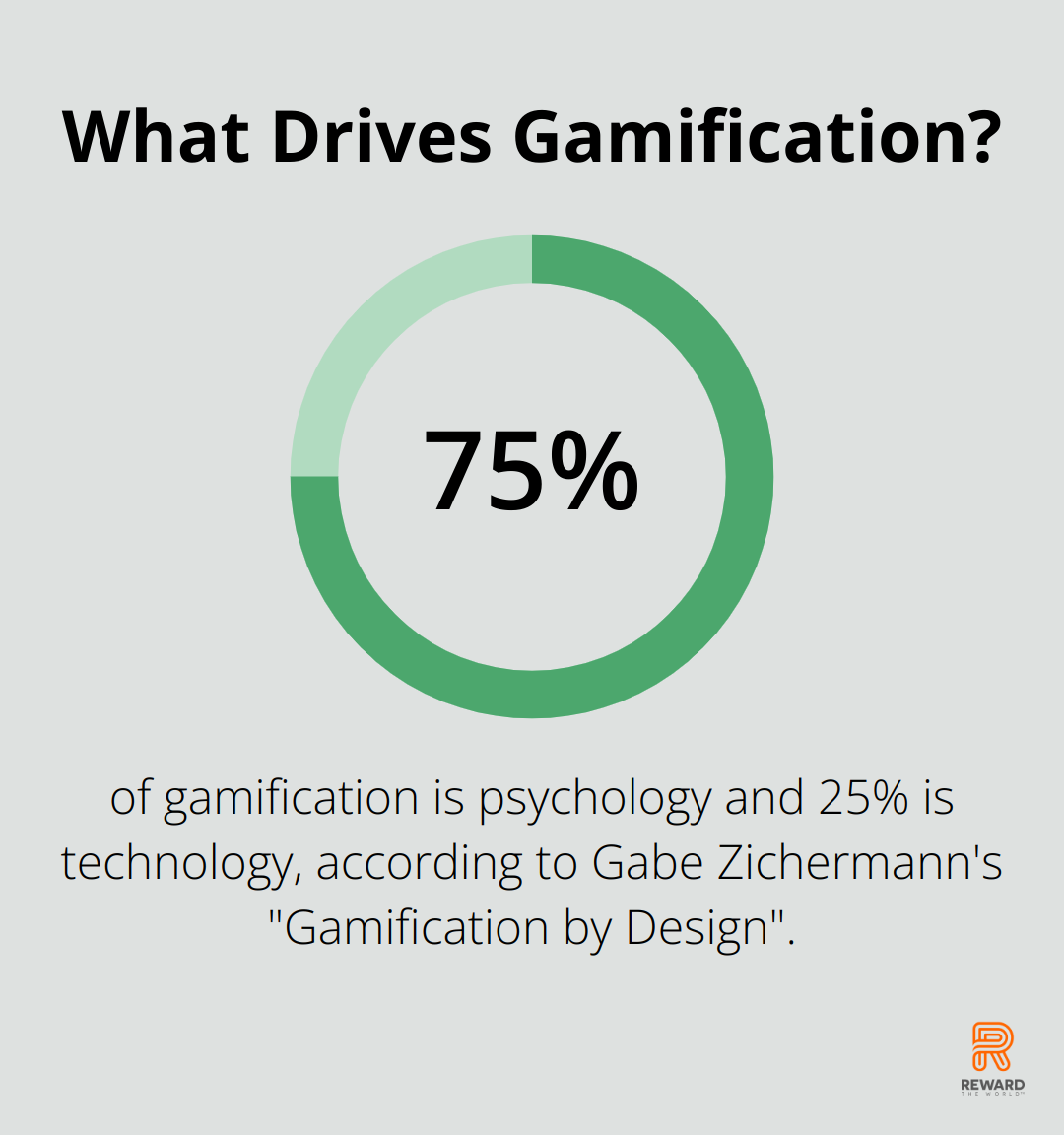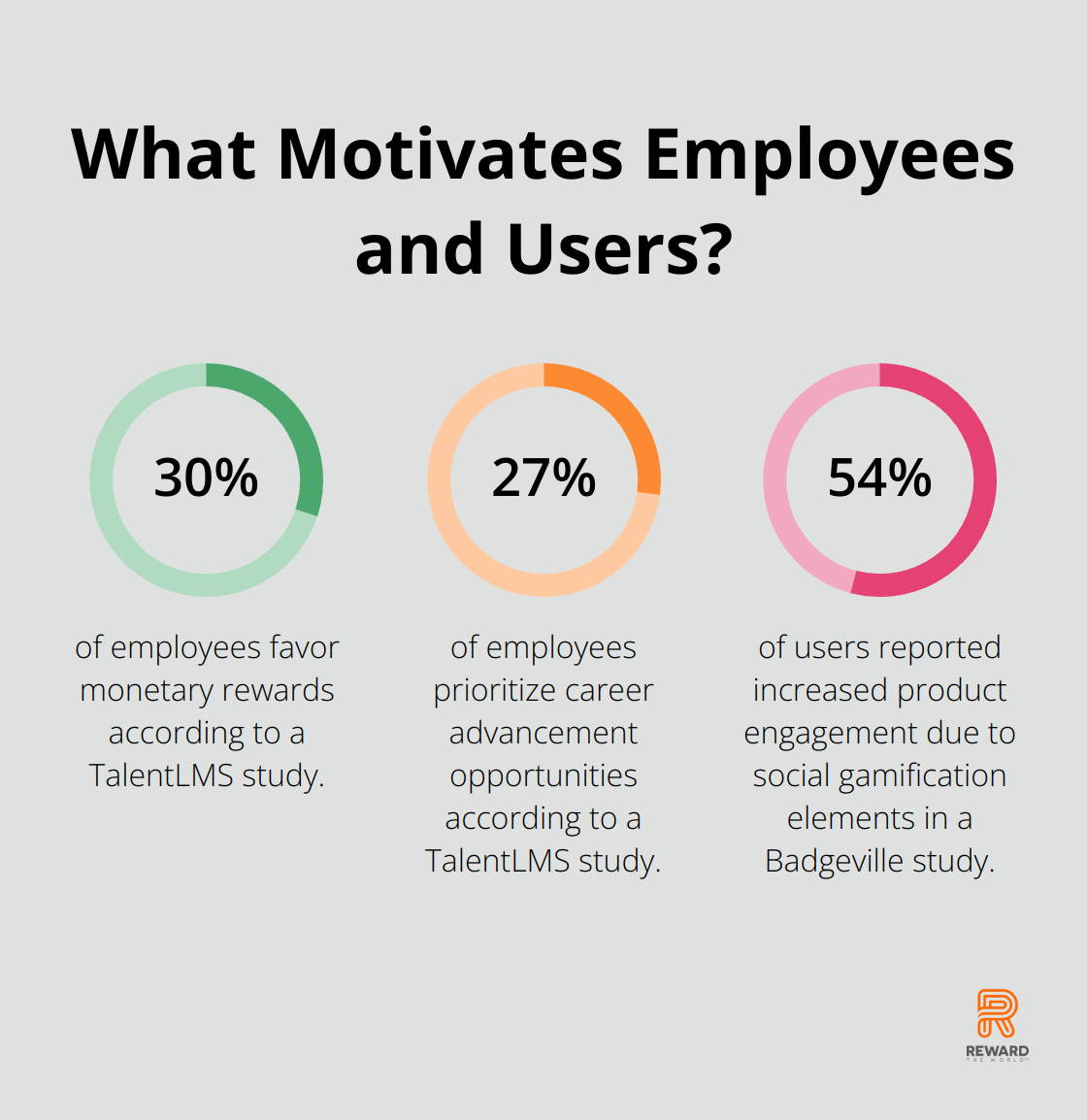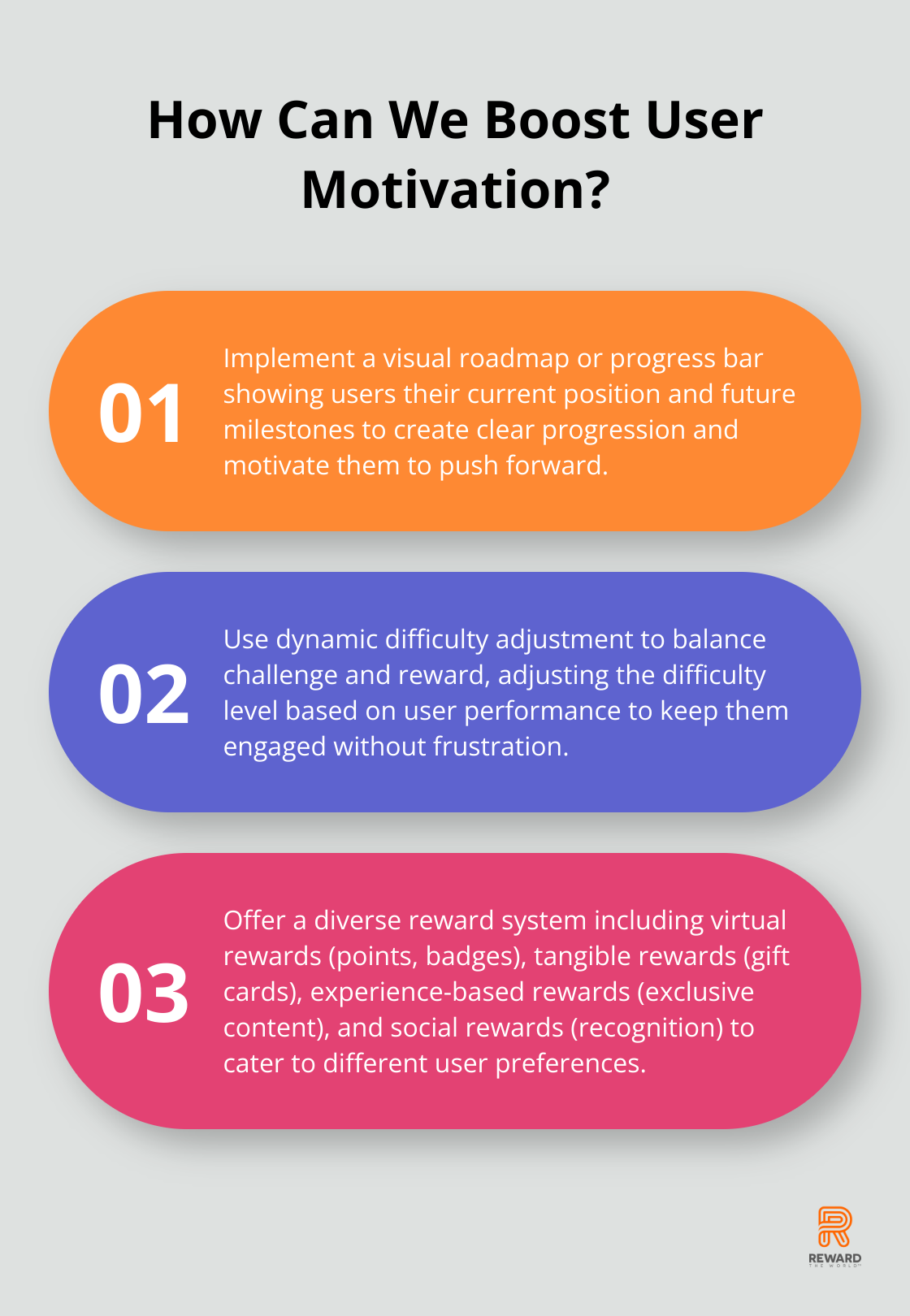
Gamification levels are the backbone of engaging user experiences. They provide structure, motivation, and a sense of progress that keeps users coming back for more.
At Reward the World, we’ve seen firsthand how well-designed levels can transform user engagement and retention. In this post, we’ll share our insights on creating effective gamification levels that drive results.
What Are Gamification Levels?
The Building Blocks of User Progression
Gamification levels form the foundation of user progression in a gamified system. They offer a structured path for users to follow, presenting increasing challenges and rewards as they advance. Well-designed levels can significantly boost user engagement and retention.
The Power of Progressive Challenges
Effective gamification levels increase in difficulty gradually, which keeps users engaged without overwhelming them. Implementing gamification can lead to a substantial 47% increase in customer engagement. This progressive challenge system taps into users’ intrinsic motivation to improve and achieve (a key factor in sustained engagement).
Rewards That Matter
Rewards play a vital role in gamification levels. They must be meaningful and align with user goals. Effective reward systems offer a variety of incentives (e.g., points, badges, or tangible rewards) to cater to different user preferences.
Feedback Loops for Continuous Improvement
Immediate feedback is essential in effective level design. It helps users understand their progress and areas for improvement. This rapid feedback maintains user engagement and motivates them to progress through levels.
Structuring Content for Maximum Impact
Gamification levels do more than just structure content; they serve as a powerful tool for driving user behavior, increasing engagement, and achieving business objectives. Educational gamification motivates students and supports social engagement, critical thinking, and personalization. Companies that implement well-designed levels create a more engaging and rewarding experience for their users, which leads to improved retention and better overall results.

As we move forward, let’s explore how to design progressive and balanced levels that keep users motivated and engaged throughout their journey.
How to Design Levels That Keep Users Hooked
The Power of Clear Progression
A clear level structure forms the foundation of effective gamification. Users should always know their position and what’s next. LinkedIn’s skill assessments offer a straightforward progression path. Users see which skills they’ve mastered and which ones remain to be conquered. This clarity motivates users to push forward.

To implement this in your system, create a visual roadmap that shows users their current position and future milestones. This could be a simple progress bar or a more elaborate map-like interface (depending on your platform’s complexity).
Balancing Challenge and Reward
Finding the sweet spot between challenge and reward keeps users engaged. Too easy, and users get bored. Too hard, and they get frustrated. Gamification is 75% psychology and 25% technology, according to Gabe Zichermann’s “Gamification by Design”.
One effective strategy uses dynamic difficulty adjustment. This technique adjusts the challenge level based on the user’s performance. If a user struggles, the system might offer hints or easier tasks. If they breeze through, it might introduce more complex challenges.
Skill Development as a Core Component
Incorporating skill development into your level design not only keeps users engaged but also adds real value to their experience. Duolingo, the language learning app, excels at this. Each level introduces new vocabulary and grammar concepts, building on previous lessons.
To apply this in your gamification system, identify the key skills or knowledge areas relevant to your platform. Then, structure your levels to gradually introduce and reinforce these skills. A fitness app might start with basic exercises and progressively introduce more complex routines as users level up.
Learning Curves That Motivate
The concept of a learning curve plays a vital role in gamification. A well-designed learning curve keeps users in what psychologists call the “flow state” – a balance between anxiety and boredom where engagement peaks.
Strava, the fitness tracking app, exemplifies this with its challenge system. Personalized and group challenges drive user motivation and app engagement. They use Badge reward systems to boost app engagement and user participation.
When designing your learning curve, start with easily achievable goals to build user confidence. Gradually increase the complexity, but always provide the tools and knowledge needed to succeed at each new level.
Effective level design in gamification crafts an experience that keeps users motivated, challenged, and rewarded. Clear progression, balanced challenges, skill development, and well-crafted learning curves create a gamification system that not only engages users but also drives real results for your business. Now, let’s explore how to implement effective feedback and reward systems to further enhance user engagement and satisfy immediate gratification needs.
How to Supercharge Your Feedback and Reward Systems
Mix Up Your Rewards
Variety is the key to effective rewards. Different users respond to different motivators. Some prefer points, others value badges, and many desire tangible rewards. A TalentLMS study revealed that 30% of employees favor monetary rewards, while 27% prioritize career advancement opportunities.

To implement a diverse reward system:
- Offer virtual rewards (points, badges, levels)
- Include tangible rewards (gift cards, merchandise)
- Provide experience-based rewards (exclusive content, early access)
- Incorporate social rewards (recognition, leaderboard positions)
Make Progress Crystal Clear
Users need clarity about their status and next steps. Clear progress indicators maintain motivation and engagement. Duolingo uses a ‘streak’ feature to motivate users to maintain consistent daily app usage, encouraging consistent learning habits.
To create effective progress indicators:
- Use visual cues like progress bars or level indicators
- Celebrate regular milestones
- Provide detailed performance analytics
- Send push notifications for achievements and next steps
Harness the Power of Social
Social elements and competition can significantly boost engagement. Strava (a fitness tracking app) excels at this with its segment leaderboards and social sharing features. A Badgeville study found that 54% of users reported increased product engagement due to social gamification elements.
To incorporate social elements:
- Implement leaderboards (while avoiding demotivation of lower-ranked users)
- Create team challenges to promote collaboration
- Allow achievement sharing on social media
- Enable user-to-user interactions within your platform
Optimize Timing for Maximum Impact
The timing of feedback and rewards can make or break your system. Immediate feedback is essential for maintaining engagement. Gamification and simulations can be leveraged by L&D to transform employee learning and enhance organizational productivity.
To optimize your timing:
- Provide instant feedback on user actions
- Use push notifications for time-sensitive rewards or challenges
- Implement a regular reward schedule to build anticipation
- Offer surprise rewards to keep users engaged
Monitor and Iterate
The success of a feedback and reward system depends on constant improvement. Observe user behavior, collect feedback, and adjust your system accordingly. This approach (which involves continuous refinement) will help you create a gamification system that drives real results for your business.
Final Thoughts
Effective gamification levels boost user engagement and drive business results. Clear progression paths, balanced challenges, and skill development opportunities form the foundation of successful gamification systems. Diverse reward systems and immediate feedback maintain user motivation, while social elements and competition enhance engagement.

The future of gamification levels will involve more sophisticated, personalized experiences. AI-driven systems will tailor challenges and rewards to individual preferences, potentially integrating augmented and virtual reality technologies. These advancements will create immersive experiences that blur the lines between digital and physical worlds.
Reward the World offers a comprehensive solution for businesses to implement effective gamification strategies. Our platform provides a wide range of reward options and analytics tools to help optimize your system over time. Companies that focus on creating engaging, balanced, and rewarding gamification levels will unlock the full potential of their user base and achieve remarkable results.
